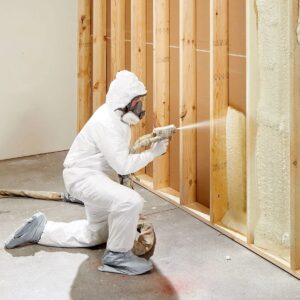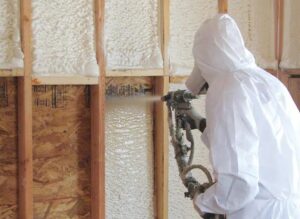Closed-cell foam insulation improves thermal performance in homes with high humidity by providing a dense, water-resistant barrier that reduces heat transfer and prevents moisture infiltration. Its rigid cellular structure blocks air and vapor flow, reducing condensation risks and mold growth within walls and ceilings. This material combines high insulation value per inch with effective moisture control, making it a reliable choice for humid climates.
This article presents a clear explanation of how closed-cell foam insulation functions in humid environments, compares it with alternative insulation options, details technical properties, and highlights key factors to consider before installation. Tables simplify complex data, while practical insights and market trends support informed decision-making.
Closed-Cell Foam and Moisture Resistance Compared to Other Insulation
Closed-cell foam stands out among insulation materials for its ability to block water vapor and air movement. Its tightly packed cells filled with gas reduce permeability, which prevents moisture from passing through the insulation and settling inside wall cavities or attics. This lowers the chance of mold development and structural damage caused by trapped moisture.
Open-cell foam, by contrast, has an open cellular structure that allows air and water vapor to pass through more easily, making it less suitable for humid environments without additional vapor barriers. Traditional fiberglass and cellulose insulation absorb moisture readily, causing their thermal efficiency to drop and increasing mold risks.
The table below compares common insulation types for humid homes, focusing on moisture resistance, thermal performance, air sealing, and cost.
| Insulation Type | Moisture Resistance | R-Value per Inch | Air Seal Effectiveness | Mold Resistance | Cost per Sq. Ft (USD) |
|---|---|---|---|---|---|
| Closed-Cell Foam | High | 6.5 – 7 | Excellent | Excellent | $1.00 – $1.50 |
| Open-Cell Foam | Low to Moderate | 3.5 – 3.7 | Good | Moderate | $0.40 – $0.75 |
| Fiberglass Batt | Low | 2.9 – 3.8 | Poor | Poor | $0.30 – $0.60 |
| Mineral Wool | Moderate | 3.7 – 4.2 | Moderate | Good | $0.60 – $1.10 |
| Cellulose (Dense-Pack) | Low | 3.2 – 3.8 | Moderate | Low | $0.50 – $0.85 |
Closed-cell foam creates an air-tight, water-resistant seal that prevents warm, humid outdoor air from entering the home’s interior and condensing on cooler surfaces inside. This ability to reduce air leaks lowers energy costs and minimizes moisture damage, which is especially important in climates with high seasonal humidity.
Technical Properties of Closed-Cell Foam Relevant to Humid Climates
The physical and thermal properties of closed-cell foam help explain its effectiveness in humid environments. The following table lists key specifications important for understanding how this material performs.
| Property | Specification |
|---|---|
| Density | 1.75 – 2.2 lbs/ft³ |
| Water Vapor Permeability | ≤ 1.0 perm at 1.5” thickness (vapor retarder rating) |
| Air Impermeability | Meets ASTM E2178 standard |
| Compressive Strength | 25 – 30 psi |
| R-Value | 6.5 – 7.0 per inch |
| Service Temperature | -40°F to 180°F |
| Expansion Rate | 30x original liquid volume |
The low water vapor permeability classifies closed-cell foam as a vapor retarder. This means it slows the diffusion of moisture through walls and ceilings, reducing the chances of condensation buildup within structural cavities. Its high compressive strength provides structural support to framing members, which can be beneficial in load-bearing areas prone to moisture intrusion.
Bonus Tip: Closed-cell foam’s expansion during application fills cracks and gaps, enhancing air sealing beyond simple insulation.
Effects of Moisture on Insulation in Humid Homes
High humidity increases the risk of condensation forming inside building assemblies. When warm, moist air meets cooler surfaces in walls or ceilings, water vapor condenses into liquid, which insulation materials can absorb. Moisture reduces insulation effectiveness by lowering the R-value and may cause corrosion, wood rot, and mold growth.
Closed-cell foam blocks moisture movement effectively, limiting condensation risks. Unlike fiberglass or cellulose, it does not absorb water, maintaining its insulating properties even in damp conditions.
In addition to stopping moisture intrusion, closed-cell foam also acts as an air barrier. By sealing gaps, it reduces drafts that carry humid air into insulation cavities, further minimizing condensation. This reduces the chance of fungal growth and improves indoor air quality.
Application Areas Best Suited for Closed-Cell Foam in High Humidity
Closed-cell foam performs well in several critical areas of humid homes:
- Crawl spaces: Ground moisture often seeps through crawl space walls and floors. Applying closed-cell foam forms a continuous vapor barrier, reducing moisture transmission into the home.
- Basement walls: These below-grade surfaces are vulnerable to dampness and water intrusion. Closed-cell foam creates a waterproof barrier that helps protect foundation walls from seepage.
- Exterior walls: Spraying closed-cell foam inside stud cavities and rim joists seals air leaks and reduces moisture infiltration from humid outdoor air.
- Unvented attics: Sealing attics with closed-cell foam prevents warm, humid air from entering and condensing on roof decks and framing.
Bonus Tip: In hurricane or flood-prone areas, closed-cell foam limits water damage caused by wind-driven rain penetrating exterior walls.
Market Trends and Regional Use
The use of closed-cell foam in humid coastal regions has increased notably in recent years. A 2024 IBHS report documented a 38% rise in adoption across the Southeastern United States from 2020 to 2023. This growth is driven by the material’s superior moisture resistance, which aligns with insurance companies’ recommendations for homes exposed to humid air and severe weather.
Builders and contractors report fewer moisture-related claims in homes insulated with closed-cell foam, contributing to improved homeowner satisfaction and resilience.
Things to Consider Before Making a Decision
Choosing closed-cell foam requires weighing several factors beyond its performance benefits.
- Cost: Closed-cell foam costs more than traditional insulation options. Budget constraints may require balancing insulation type with other construction priorities.
- Installation: It requires specialized equipment and trained professionals due to its chemical components and spray application process.
- Thickness and Space: The foam’s dense nature limits how thick it can be applied in some cavity spaces without interfering with electrical or plumbing lines.
- Climate Considerations: Vapor permeability requirements differ by region. In some climates, excessive vapor barrier properties can trap moisture inside walls, so proper ventilation and building design are crucial.
- Environmental Impact: Closed-cell foam uses blowing agents with global warming potential; newer formulations aim to reduce this effect but vary by manufacturer.
Bonus Tip: Consult local building codes and a qualified insulation expert to tailor the installation to your home’s climate zone and construction type.
Common Questions
Is closed-cell foam safe for humid climates? Yes, its low permeability and moisture resistance make it suitable for high-humidity environments.
Can it trap moisture inside walls? If installed incorrectly, closed-cell foam can create moisture traps. Proper ventilation and vapor management prevent this.
How long does closed-cell foam last? It maintains insulation performance for 30 years or more under typical conditions.
Can homeowners install it themselves? DIY installation is not recommended due to health and safety risks and the need for precise application.
Is it worth the higher upfront cost? Long-term energy savings and reduced moisture damage often justify the investment in humid climates.
Energy Efficiency Impact in Humid Regions
Closed-cell foam’s high R-value and air sealing improve energy efficiency by reducing cooling loads in humid climates, where air conditioning is heavily used. Its moisture resistance also prevents insulation degradation, maintaining performance over time.
| Insulation Type | Estimated Cooling Savings (%) | Moisture Risk if Improperly Installed |
|---|---|---|
| Closed-Cell Foam | 25 – 35% | Low |
| Open-Cell Foam | 15 – 20% | Moderate to High |
| Fiberglass Batt | 5 – 10% | High |
Homes with closed-cell foam insulation show lower humidity-related damage and maintain more consistent indoor temperatures, reducing HVAC system strain and costs.
Topic FAQ
What makes closed-cell foam better than open-cell foam in humid areas? Closed-cell foam is dense and water-resistant, blocking moisture and air. Open-cell foam allows moisture to pass and can absorb water.
Does closed-cell foam reduce indoor humidity? It prevents external moisture infiltration but does not remove existing indoor humidity.
Can closed-cell foam be combined with other insulation? Yes, it often pairs with other materials to balance cost and performance.
Is closed-cell foam compliant with wet climate building codes? Most codes allow it, but local rules on vapor barriers vary. Verify with local authorities.
Will closed-cell foam solve existing mold issues? No, it prevents new mold by controlling moisture but does not remove mold already present.
Make the Right Decision
A closed-cell foam insulation contractor offers a robust solution to insulation challenges in humid homes by blocking moisture and providing superior thermal resistance. While its higher upfront cost and installation complexity require careful planning, the long-term benefits include improved energy efficiency, reduced mold risk, and enhanced durability. Evaluate your climate, building type, and budget with professional guidance to determine if closed-cell foam is the best fit for your project. Use proper ventilation and vapor control measures to optimize performance and protect your home.
Reviewer: Maria Lopez reviewed the article and brought 12 years of insulation industry experience to improve the guidance. Practical tips were added, and the content was made clearer and more useful for contractors working in the field every day.

